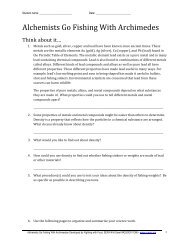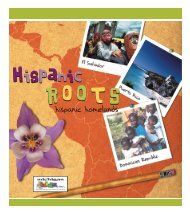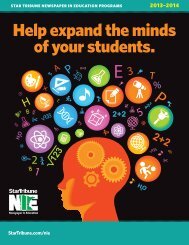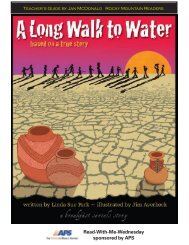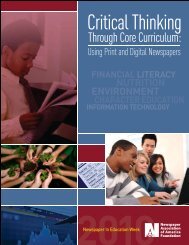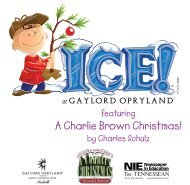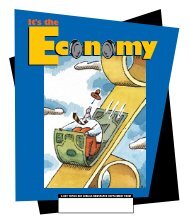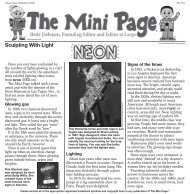News, views and issues that affect our lives every day.
News, views and issues that affect our lives every day.
News, views and issues that affect our lives every day.
- No tags were found...
Create successful ePaper yourself
Turn your PDF publications into a flip-book with our unique Google optimized e-Paper software.
Parents bewareTeens are turning away from streetdrugs <strong>and</strong> using prescription drugs toget high. Next to marijuana, the mostcommon illegal drugs teens are using toget high are prescription medications.Teens are abusing prescription drugsbecause they believe the myth <strong>that</strong>these drugs provide a medically safehigh.The majority of teens get prescriptiondrugs easily <strong>and</strong> for free, often fromfriends or relatives. Girls are morelikely than boys to intentionally abuseprescription drugs to get high.Pain relievers such as OxyContin<strong>and</strong> Vicodin are the most commonlyabused prescription drugs by teens.Adolescents are more likely thanyoung adults to become dependent onprescription medication.S<strong>our</strong>ce: Office of National Drug Control PolicyPrescription drug dangersWhen taken properly <strong>and</strong> undera medical provider’s supervision,prescription drugs can have manybenefits. Prescription drugs, as well asover-the-counter (OTC) drugs, can bedangerous, especially when abused.There are serious health risksassociated with the abuse ofprescription drugs. A single large doseof prescription or OTC painkillers ordepressants can result in breathingproblems <strong>that</strong> will lead to death.Stimulant abuse can lead to violentor paranoid behavior or even fatalseizures.In small doses, depressants <strong>and</strong>painkillers can <strong>affect</strong> a person’s motorskills, judgment or the ability to learn.The abuse of OTC cough <strong>and</strong> coldremedies can cause blurred vision,nausea, vomiting, dizziness, coma <strong>and</strong>death.Young people report many reasonsfor abusing prescription <strong>and</strong> OTC drugs.Sometimes teens <strong>and</strong> college-agestudents use prescription <strong>and</strong> over-thecounterdrugs to get high. This might beto party, to escape reality, to experimentor to relieve boredom.However, some people say theyabuse these drugs to help them cope, todeal with pressures or to self-medicateto relieve pain or sleep better.S<strong>our</strong>ce: Parents. The Anti-Drug.Children <strong>and</strong> caregiversbewarePrescription drug abuse is mostcommon in young people (ages 12-17),women <strong>and</strong> older adults. While people65 years of age <strong>and</strong> above compriseonly 13 percent of the population, theyaccount for approximately one-third ofall medications prescribed in the UnitedStates. Older patients are more likely tobe prescribed long-term <strong>and</strong> multipleprescriptions, which could lead tounintentional abuse.The elderly also are at risk forprescription drug abuse, in whichthey intentionally take medications<strong>that</strong> are not medically necessary. Inaddition to prescription medications, alarge percentage of older adults alsouse over-the-counter medicines <strong>and</strong>dietary supplements.Because of the elderly’s high ratesof having multiple illnesses, changesin drug metabolism with age <strong>and</strong>the potential for drug interactions,prescription <strong>and</strong> over-the-counter drugabuse <strong>and</strong> misuse can have dangeroushealth consequences. Health careproviders, primary care physicians<strong>and</strong> pharmacists, as well as patientsthemselves <strong>and</strong> their caregivers, all canplay a role in identifying <strong>and</strong> preventingprescription drug abuse.learning with the times student activityAnalyzing advertisementsA drug is any non-food substance <strong>that</strong>when put into the body changes theway the body or mind works. Physiciansmay prescribe legal drugs. Over-thecounterdrugs may be purchased at drugstores or other retail stores. <strong>News</strong>papers,the Internet <strong>and</strong> television frequentlycontain advertising for drugs. Monitor theJust the Facts• In 2009, there were 7 millionAmericans aged 12 years<strong>and</strong> older who abusedprescription drugs for nonmedicalpurposes withinthe past month, up from 6.2million in 2008.• In 2009, on average, 6,027persons per <strong>day</strong> abusedprescription pain relieversfor the first time.• Every <strong>day</strong>, on average, 2,500teens use prescription drugsto get high for the first time.• Sixty percent of teens whoabused prescription painrelievers did so before theage of 15.• According to the Centersfor Disease Control,prescription drugs,including opioids <strong>and</strong>antidepressants, areresponsible for moreoverdose deaths than“street drugs” such ascocaine, heroin <strong>and</strong>amphetamines.S<strong>our</strong>ce: Drug Enforcement AdministrationTampa Bay Times, tbt* <strong>and</strong> y<strong>our</strong> favoritetelevision station for a week. In y<strong>our</strong>j<strong>our</strong>nal, write down each time you see anadvertisement for a prescription or overthe-counterdrug. As a consumer, do youthink you are being bombarded with theseimages? What is the message <strong>that</strong> is beingconveyed in these advertisements?tampabay.com/nie 1213tampabay.com/nie 13



